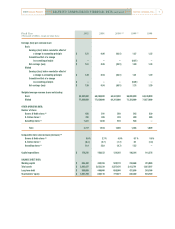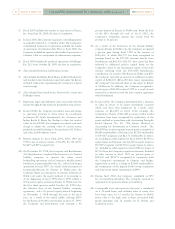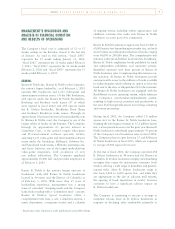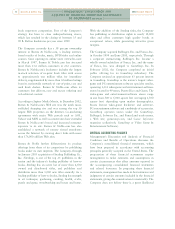Barnes and Noble 2002 Annual Report Download - page 18
Download and view the complete annual report
Please find page 18 of the 2002 Barnes and Noble annual report below. You can navigate through the pages in the report by either clicking on the pages listed below, or by using the keyword search tool below to find specific information within the annual report.
margin decreased to 5.8% of sales during fiscal 2001,
before the effect of the legal settlement expense, from
6.5% of sales during fiscal 2000, before the effect of
the impairment charge.
Interest Expense, Net and Amortization
of Deferred Financing Fees
Interest expense, net of interest income, and amortization
of deferred financing fees, decreased $17.2 million to
$36.3 million in fiscal 2001 from $53.5 million in fiscal
2000. The decrease was primarily the result of reduced
borrowings due to effective working capital management
and lower interest rates on the Company’s outstanding
debt, partially through the issuance of the Company’s
convertible subordinated notes sold in March 2001.
Equity in Net Loss of Barnes & Noble.com
In November 2000, Barnes & Noble.com acquired
Fatbrain.com, Inc. (Fatbrain), the third largest online
bookseller. Barnes & Noble.com issued shares of its
common stock to Fatbrain shareholders. As a result
of this merger, the Company and Bertelsmann each
retained an approximate 36 percent interest in Barnes
& Noble.com. Accordingly, the Company’s share in
the net loss of Barnes & Noble.com is based on an
approximate 40 percent equity interest from the
beginning of fiscal 2000 through November 2000 and
approximately 36 percent thereafter. The Company’s
equity in the net loss of Barnes & Noble.com for fiscal
2001 and fiscal 2000 was $88.4 million and $103.9
million, respectively.
Other Expense
Other expense of $11.7 million in fiscal 2001 was
due to $4.0 million in equity losses in iUniverse.com,
$2.5 million in equity losses in BOOK®magazine and
$5.5 million in equity losses in enews, inc., partially
offset by a one-time gain of $0.3 million from the
partial sale of Indigo. Other expense of $9.3 million in
fiscal 2000 was primarily due to the equity losses of
iUniverse.com, partially offset by a one-time gain of
$0.3 million from the partial sale of iUniverse.com.
Provision for Income Taxes
Barnes & Noble’s effective tax rate in fiscal 2001 decreased
to 41.5 percent compared with (57.5) percent during fiscal
2000. The fiscal 2001 decrease was primarily related to the
goodwill write-down associated with the impairment
charge, which provided no tax benefit in fiscal 2000.
Earnings (Loss)
As a result of the factors discussed above, the Company
reported consolidated net earnings of $64.0 million (or
$0.94 per share) during fiscal 2001 compared with a
net loss of ($52.0) million (or ($0.81) per share) during
fiscal 2000. Components of diluted earnings per share
are as follows:
Fiscal Year 2001 2000
Retail EPS $ 1.70 1.69
EPS Impact of Investing Activities
Share in net losses of
Barnes & Noble.com ( 0.66 ) ( 0.98 )
Share of net losses from other
investments (including
earnings from Calendar Club) ( 0.07 ) ( 0.08 )
Total Investing Activities $ ( 0.73 ) ( 1.06 )
Other Adjustments
Legal settlement expense $ ( 0.03 ) --
Impairment charge -- ( 1.44 )
Total Other Adjustments $ ( 0.03 ) ( 1.44 )
Consolidated EPS $ 0.94 ( 0.81 )
SEASONALITY
The Company's business, like that of many retailers, is
seasonal, with the major portion of sales and operating
profit realized during the quarter which includes the
holiday selling season.
LIQUIDITY AND CAPITAL RESOURCES
Working capital requirements are generally at their
highest in the Company's fiscal quarter ending on or
about January 31 due to the higher payments to
vendors for holiday season merchandise purchases.
In addition, the Company’s sales and merchandise
inventory levels will fluctuate from quarter to quarter
as a result of the number and timing of new store
openings, as well as the amount and timing of sales
contributed by new stores.
Cash flows from operating activities, funds available
under its revolving credit facility and short-term vendor
17
2002 Annual Report Barnes & Noble, Inc.
[MANAGEMENT’S DISCUSSION AND
ANALYSIS OF FINANCIAL CONDITION AND RESULTS
OF OPERATIONS continued ]
























